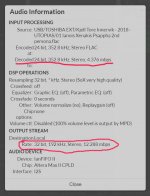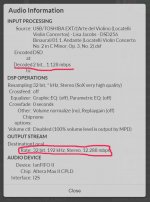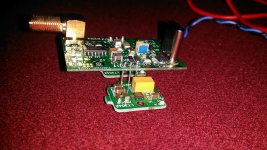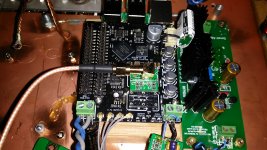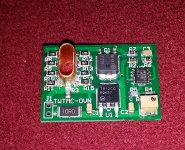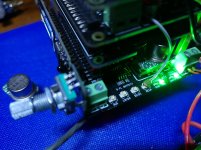Share the moode settings, RPi4 > FiFoPi > HDMIPi > ES9038 Pro DAC , all CDs convert to AIFF and DSD to DSF, copy all files to SDCARD, Moode sounds sharper, compared to another setting, NUC (JPlay) > UDA BULK ASIO > FiFoPi > HDMIPi.


I have sussed the noise issue....it only does it on the 2 highest SOX sampling rates....32bit 352 and 32/384. All other rates work fine.
This may mean something to you guys!
Hi guys,
I have the same kind of problem with fifopi (45/49) and 9038q2m dual mono.
Using IANFIFO II driver in Moode, I can't output higher than 32/192
(If I use audiophonics 9038 driver, I can output up to 32/384 but I get a lot of noise.)
Does some of you know a fix for this problem?
Thanx
Attachments
Hi Ian, I got ES9038q2m+Controller, thx!
I have a question about I/V stage on transformers.
Have you tried earlier not to merge 2 outputs of one ES9038q2m (for dual mono version) before the transformer to allow transformer to do this job itself? I mean the connection:
DACR+DACRB->Prim.coil#1 of transformer
DACL+DACLB->Prim.coli#2 of transformer
Previously there was some findings from Mr.Teramoto that it was better choice for ES9018S to merge all 4 outputs after transformer.
If you have not tried such a connection, then is there any chance to check it on your dual mono DAC (is there possibility to catch lines somewhere before merging?) Or is it impossible within curent board revision? Thank you!
I have a question about I/V stage on transformers.
Have you tried earlier not to merge 2 outputs of one ES9038q2m (for dual mono version) before the transformer to allow transformer to do this job itself? I mean the connection:
DACR+DACRB->Prim.coil#1 of transformer
DACL+DACLB->Prim.coli#2 of transformer
Previously there was some findings from Mr.Teramoto that it was better choice for ES9018S to merge all 4 outputs after transformer.
If you have not tried such a connection, then is there any chance to check it on your dual mono DAC (is there possibility to catch lines somewhere before merging?) Or is it impossible within curent board revision? Thank you!
Did some back to back with lundalh and opamp iv today. The transformer stage beats it in every way. Soundstage, timbre, scale, it has none of the hf glare of the opamp iv stage
Terry use the generic i2s driver.
Hi, thank you for the help.
I just tried:
- generic1 i2s(hifiberry) outputs at max 32/192
- generic2 i2s(rpi-dac) outputs at max 24/192
- audiophonics outputs max at 32/384 but I can’t play dsd128 and Dsd256 dop, because of a lot of suttering.
I had the same problem with ian isolator and allo katana where the max output is 32/176 for dop dsd playing.
Any ideas why?
Last edited:
Hi Simon.
It is a hifiberry dac+pro...master mode. It has 2 clocks. Not sure what speeds without looking up. It worked fine on the highest settings without the isolator. Doesn't bother me as I cant tell any difference with the Lower settings.
See post #260 in this thread:
Getting the best out of Allo.com's new Katana DAC...
Though the response is from Allo on their isolator, both Allo's & Ian's work the same with similar isolation devices.
Greg in Mississippi
See post #260 in this thread:
Getting the best out of Allo.com's new Katana DAC...
Though the response is from Allo on their isolator, both Allo's & Ian's work the same with similar isolation devices.
Greg in Mississippi
Thank you Greg.
See post #260 in this thread:
Getting the best out of Allo.com's new Katana DAC...
Though the response is from Allo on their isolator, both Allo's & Ian's work the same with similar isolation devices.
Greg in Mississippi
or click here 🙂
https://www.diyaudio.com/forums/pc-based/329911-getting-allo-coms-katana-dac-26.html#post5680696
LOL... THANKS Randy!
Off-topic... the maximum number of posts displayed per page can be set to something other than the default if one is a contributor. I am and have mine set to the max of 50 posts per page. Links are parsed by page number based on the default number of posts per page, so my links don't connect to the correct posts for most people... and others' links don't parse for me (AND I just re-confirmed that by clicking on Randy's link).
'So I don't post links to specific posts, just a general thread link and a post number.
Likely more than ANYONE wanted to know on this!
Greg in Mississippi
Off-topic... the maximum number of posts displayed per page can be set to something other than the default if one is a contributor. I am and have mine set to the max of 50 posts per page. Links are parsed by page number based on the default number of posts per page, so my links don't connect to the correct posts for most people... and others' links don't parse for me (AND I just re-confirmed that by clicking on Randy's link).
'So I don't post links to specific posts, just a general thread link and a post number.
Likely more than ANYONE wanted to know on this!
Greg in Mississippi
SupersurferGuys,
I finished my first Andrea Mori sc-cut clock and it is now running in on the fifopi.
After 4 hours playing it is already far ahead of the crystec I had as previous reference.
This is sounding so much better; more dynamics, more openness, deeper and wider soundstage, easier to hear all the details, more focussed sound / less smearing. Did I mention dynamics?
I have planned to build an oven to run it on the ideal temp. So the phase noise will be even lower.
This is a highly reccommended addition.
I followed your lead and fired up the WTMC SC cut @ 45mHz before building the oven. Without your post I would never have thought about running it without the oven and a best effort power supply.
It is a preview of greatness to come. Even on a mediocre linear PS and just hanging by its wires it is a major step forward over the NDK SDA it replaced. The NDK was no slouch with very good PS, supercaps and BG HiQ caps.
I am getting similar result to your description. Big step closer to real sounds of instruments, voices & percussion. It is a good upgrade for me. I value micro details, laid back reality and dynamics.
As with previous clock upgrades the increase in dynamics and lowering of sound floor makes it sound louder even at the same measured db at seating position.
Current plans are to add the oven and put the master clock in its own chassis with SMA cable to FIFOpi.
Thanks Andrea!!
Attachments
Supersurfer
I followed your lead and fired up the WTMC SC cut @ 45mHz before building the oven. Without your post I would never have thought about running it without the oven and a best effort power supply.
It is a preview of greatness to come. Even on a mediocre linear PS and just hanging by its wires it is a major step forward over the NDK SDA it replaced. The NDK was no slouch with very good PS, supercaps and BG HiQ caps.
I am getting similar result to your description. Big step closer to real sounds of instruments, voices & percussion. It is a good upgrade for me. I value micro details, laid back reality and dynamics.
As with previous clock upgrades the increase in dynamics and lowering of sound floor makes it sound louder even at the same measured db at seating position.
Current plans are to add the oven and put the master clock in its own chassis with SMA cable to FIFOpi.
Thanks Andrea!!
Hi Wlowes,
Good to know you have a similar experience! After the holiday season I will start with the oven.
I see you use the black gate standard on the input of the fifopi (for powering rpi?) and a supercap soldered on the board. Did you experiment with these components (and placement)? I use a supercap on the input connector (and the bg on the iv-board), I am not sure the supercap is a good solution soundwize, the bg’s have never failed me though.
My standard cap placements (after years of experimenting) are to use oscon for digital circuits and elna silmic or black gate for analog.
Silmic makes the sound more silky, the black gates (standards) give more blackness and low end power.
Regards,
Last edited:
You were right when you said it's a game changer. I leave the digital front end powered 7/24 so it is starting to burn in. I listened today and it was totally changed (better) after 3 days on the oscillator and 24hrs on the squarer. It is truly one of those times you need to re-listen to the entire collection. I built the oven, but still need to build a PS so I have not heard the clock with the oven. I'll report impressions in a few weeks when it's finished and burned in.Hi Wlowes,
Good to know you have a similar experience! After the holiday season I will start with the oven.
I see you use the black gate standard on the input of the fifopi (for powering rpi?) and a supercap soldered on the board. Did you experiment with these components (and placement)? I use a supercap on the input connector (and the bg on the iv-board), I am not sure the supercap is a good solution soundwize, the bg’s have never failed me though.
My standard cap placements (after years of experimenting) are to use oscon for digital circuits and elna silmic or black gate for analog.
Silmic makes the sound more silky, the black gates (standards) give more blackness and low end power.
Regards,
I played around a bit with supercap positioning. The cap on the FIFOpi clean power rail is a winner. Dynamics, slam /attack are the result. It's a keeper for me.
I think you missed the BG HiQ on the FIFOpi on the power pins of the masterclock output buffer. Cleans up the signal and adds that nice BG touch you mentioned. Highly recommended.
Like you, I like the results from BlackGates. I think I counted 75 in total across the system.
The Rpi power has a BG F 100u. I can't say if it is warranted or not. I have quite a good linear supply to the pi and just add the BG for good measure. Putting the same cap on the + and - pins of the TDA1541a had a major impact. The pi PS also important but not as much impact.
Also placed a supercap on the I2StoPCM power rail with good impact.
I can also relate to your comment about having a system capable of revealing the small stuff. I also have open baffle speakers with minimal crossovers. Amps are 6c33c OTL and very transparent. Slagle autoformer line-stage, and dual mono triode output on the DAC. I keep resistors to a minimum, and use hand wound manganin in all the key places. The result is that every improvement in the front end shines as everything downstream is capable of much more.
Attachments
Last edited:
I am using picoreplayer with Fifopi with HDMI transmitter to my R2R DAC. Is there a particular setting that I need to use to get DSD 256. I can only get DSD64 to play. Any help is appreciated. Thanks!
Hi Ian, I got ES9038q2m+Controller, thx!
I have a question about I/V stage on transformers.
Have you tried earlier not to merge 2 outputs of one ES9038q2m (for dual mono version) before the transformer to allow transformer to do this job itself? I mean the connection:
DACR+DACRB->Prim.coil#1 of transformer
DACL+DACLB->Prim.coli#2 of transformer
Previously there was some findings from Mr.Teramoto that it was better choice for ES9018S to merge all 4 outputs after transformer.
If you have not tried such a connection, then is there any chance to check it on your dual mono DAC (is there possibility to catch lines somewhere before merging?) Or is it impossible within curent board revision? Thank you!
I did. But using all outputs in SE mode to transformer coils will need audio capacitors for each output. For me, balanced configuration sounds better. But I could be wrong.
Ian
Hi, thank you for the help.
I just tried:
- generic1 i2s(hifiberry) outputs at max 32/192
- generic2 i2s(rpi-dac) outputs at max 24/192
- audiophonics outputs max at 32/384 but I can’t play dsd128 and Dsd256 dop, because of a lot of suttering.
I had the same problem with ian isolator and allo katana where the max output is 32/176 for dop dsd playing.
Any ideas why?
They are mainly software issue. Can you try piCore player for 384KHz? I use this configuration without problem.
Or, reset ESS controller to factory default setting to see if any change?
Regards,
Ian
Supersurfer
I followed your lead and fired up the WTMC SC cut @ 45mHz before building the oven. Without your post I would never have thought about running it without the oven and a best effort power supply.
It is a preview of greatness to come. Even on a mediocre linear PS and just hanging by its wires it is a major step forward over the NDK SDA it replaced. The NDK was no slouch with very good PS, supercaps and BG HiQ caps.
I am getting similar result to your description. Big step closer to real sounds of instruments, voices & percussion. It is a good upgrade for me. I value micro details, laid back reality and dynamics.
As with previous clock upgrades the increase in dynamics and lowering of sound floor makes it sound louder even at the same measured db at seating position.
Current plans are to add the oven and put the master clock in its own chassis with SMA cable to FIFOpi.
Thanks Andrea!!
That's a great ! Congratulations!
Hopefully I can try this configuration soon.
Ian
received the ShieldPi, thanks ian, your service is second to none🙂 , after installing it, seem to have a darker background and better treble.
i have a problem with the 98mhz pulsar clock, both led of the clock on the fifopi
are flashing and d2 ,d3 on the e9038m dual mono is no on. happened either by
the 98mhz clock itself or together with the 90mhz pulsar clock, currently it work with just the 90mhz pulsar by itself.
i have a problem with the 98mhz pulsar clock, both led of the clock on the fifopi
are flashing and d2 ,d3 on the e9038m dual mono is no on. happened either by
the 98mhz clock itself or together with the 90mhz pulsar clock, currently it work with just the 90mhz pulsar by itself.
Attachments
received the ShieldPi, thanks ian, your service is second to none🙂 , after installing it, seem to have a darker background and better treble.
i have a problem with the 98mhz pulsar clock, both led of the clock on the fifopi
are flashing and d2 ,d3 on the e9038m dual mono is no on. happened either by
the 98mhz clock itself or together with the 90mhz pulsar clock, currently it work with just the 90mhz pulsar by itself.
Hi minivan,
pulSar doesn't have OE pin, so you can use only one of them on FifoPi. Please don't use both of them at same time.
Ian
- Home
- Source & Line
- PC Based
- IanCanada's Latest RPi GB Goodies Impressions... and your tweaks, mods and hints...
